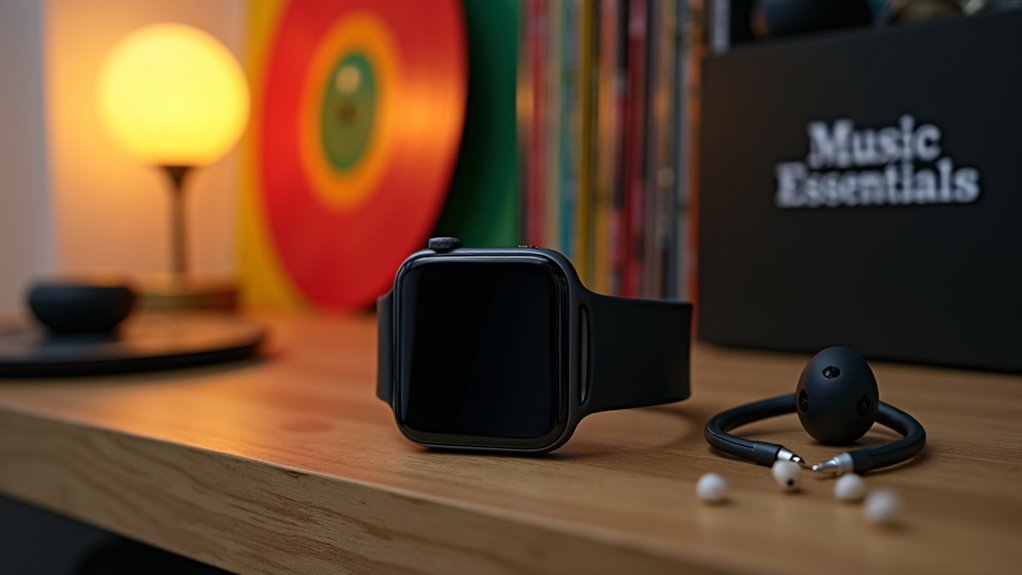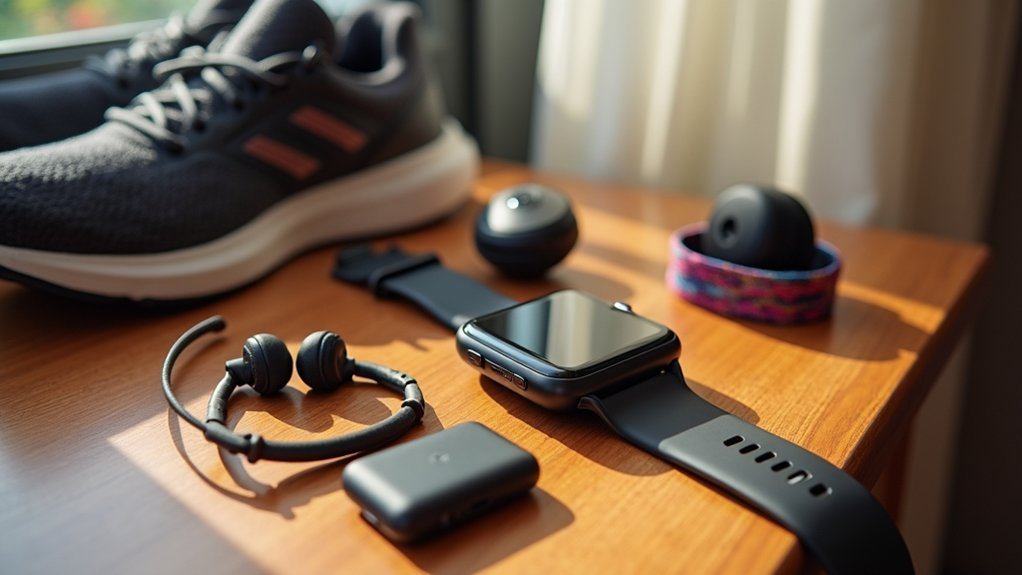You’ll want to choose 6-20+ GB storage for extensive music libraries, while casual listeners need just 2-3 GB for basic playlists. Optimize your files by converting to MP3 format at 128-192 kbps using Variable Bit Rate for the best quality-to-size ratio. Download playlists instead of streaming to nearly double your battery life during GPS-enabled runs. Create tempo-based playlists that sync across platforms using companion apps. Balance storage capacity with watch performance since larger storage often means bulkier, heavier devices that affect running comfort.
Choose the Right Storage Capacity for Your Music Needs

How much music storage do you actually need on your running watch? Your music listening habits should dictate your storage choice.
Your personal music consumption patterns, not marketing specs, should determine how much storage capacity you actually purchase for your running watch.
If you’re a casual listener who occasionally streams music, you’ll find 2-3 GB sufficient for basic offline playlists. However, dedicated music lovers who prefer extensive variety need mid-range to premium storage options offering 6-20+ GB capacity.
Consider your typical workout duration and frequency. Short runs might only require 100-200 songs, while marathon training demands larger libraries with 500+ tracks.
If you run in areas with poor cellular coverage, prioritize generous onboard storage for reliable offline playback. Premium options like advanced Garmin models typically offer the most comprehensive music storage capabilities alongside their other enhanced features.
Don’t forget about audiobooks and podcasts – they’ll consume additional space beyond your music collection.
Optimize Music File Formats to Maximize Storage Space
When you’re working with limited watch storage, choosing the right audio file format becomes essential for fitting your entire music collection. MP3 remains the most universally supported format, balancing quality and compression efficiently.
You’ll want to optimize your bit rates between 128-192 kbps for the best compromise between sound quality and storage efficiency.
Here are four key strategies to maximize your music storage:
- Convert to Variable Bit Rate (VBR) MP3 – This adjusts compression dynamically, providing better quality-to-size ratios than fixed rates.
- Use batch processing tools – Convert multiple files simultaneously using software like Audacity or iTunes with running watch presets.
- Store playlists instead of full albums – Keep only your frequently played tracks to optimize space.
- Avoid double compression – Start with high-quality sources before converting to prevent audio degradation.
Models like the Coros Pace 3 offer music storage capabilities while maintaining their lightweight design and impressive battery performance.
Manage Battery Life While Streaming Music During Runs

While streaming music during runs creates the perfect soundtrack for your workout, it transforms your running watch into a power-hungry device that’ll drain your battery nearly twice as fast as offline playback. Streaming requires constant cellular, Wi-Fi, and Bluetooth connections—all significant power draws that can reduce your watch’s battery life by up to 50%.
| Watch Model | GPS + Streaming | GPS + Downloaded Music | Battery Difference |
|---|---|---|---|
| Apple Watch | ~4 hours | ~7 hours | 43% reduction |
| Garmin Models | ~5 hours | ~8 hours | 38% reduction |
| Fitbit Ionic | ~4.5 hours | ~7 hours | 36% reduction |
To maximize battery life, pre-download playlists, reduce screen brightness, enable low power mode, and disable unnecessary notifications during runs. Additionally, streaming radio services consume significantly more battery than downloaded music due to continuous data transmission requirements.
Sync and Organize Your Playlists Efficiently
Smart battery management sets the foundation, but efficient playlist syncing transforms your running watch into a personalized music powerhouse.
Seamless playlist syncing elevates your running watch from basic timekeeper to ultimate workout companion with personalized musical motivation.
You’ll want to leverage streaming service integration and wireless connectivity to seamlessly sync your favorite tracks across all devices.
Essential Playlist Organization Strategies:
- Create tempo-based playlists that match your running pace and workout intensity to maintain consistent performance throughout your runs.
- Utilize offline storage capabilities by downloading playlists directly to your watch, ensuring uninterrupted music access during long runs without cellular coverage.
- Manage storage space efficiently by regularly updating playlists and removing unused tracks to maximize your watch’s capacity for new music.
- Sync playlists across platforms using companion apps to maintain consistent access between your smartphone, computer, and running watch.
Consider watches with 32GB storage capacity for extensive music libraries, allowing you to store thousands of songs directly on your device.
Balance Storage Features With Watch Performance

Finding the perfect balance between music storage and watch performance requires careful consideration of your priorities as a runner.
You’ll need to weigh storage capacity against other essential features like GPS accuracy, battery life, and physical comfort. The Garmin fēnix 7 Pro offers impressive 2,000-song storage but comes with a bulkier design and higher price ($799.99–$999.99).
In contrast, the Forerunner 165 Music provides 500 songs with better affordability and comfort. This lightweight watch delivers 11 days of battery life in normal mode, making it ideal for beginners who want music without sacrificing performance.
Consider what matters most: extensive music libraries or streamlined performance tracking. Larger storage often means increased size and weight, which can affect your running comfort.
Solar charging options help offset battery drain from music playback, while water resistance and heart rate monitoring shouldn’t be compromised for storage alone.
Frequently Asked Questions
Can I Transfer Music From My Watch to Another Device or Computer?
You can’t directly transfer music from your Garmin watch to another device. Garmin Express doesn’t support reverse transfers. You’ll need to remove the storage card and access files through a computer as a workaround.
What Happens to Stored Music if My Watch Gets Damaged or Malfunctions?
If your watch gets damaged, you’ll likely lose access to stored music permanently. Physical damage often affects storage components, making files unrecoverable. That’s why you should regularly backup music to cloud services or computers.
Do Music Storage Capabilities Differ Between GPS and Non-Gps Watch Models?
GPS watches typically offer more music storage than non-GPS models because they’re larger and designed with more features. You’ll find GPS watches can store hundreds to thousands of songs, while non-GPS models have limited capacity.
Can I Store Podcasts and Audiobooks Alongside Music on My Running Watch?
You can store podcasts and audiobooks alongside music on most running watches, but they’ll share the same limited storage space. You’ll need to balance all three media types within your watch’s total capacity constraints.
How Do Software Updates Affect Existing Music Storage and Compatibility Features?
Software updates can reduce your music storage space by reallocating memory for new features. They’ll also change streaming service compatibility and may improve or worsen Bluetooth connectivity with your headphones.
In Summary
You’ve got the tools to transform your running watch into the perfect musical companion. By choosing adequate storage, optimizing file formats, managing battery wisely, organizing playlists smartly, and balancing features with performance, you’ll never miss a beat during your runs. Don’t let poor music management slow you down—implement these storage strategies and you’ll enjoy seamless tunes that keep you motivated mile after mile.





Leave a Reply